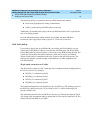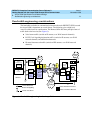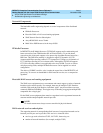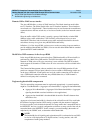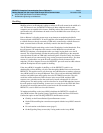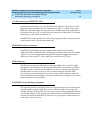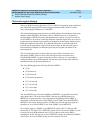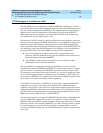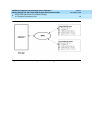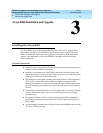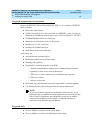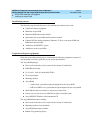
DEFINITY Enterprise Communication Server Release 9
Getting Started with the Avaya R300 Remote Office Communicator
Issue 1
November 2000
Avaya R300 Specifications and Network Design
27Network region design
2
G.729 is at the top of the Avaya R300’s capability set because it is a low bit-rate CODEC.
Since most Avaya R300s will be across the WAN from their host DEFINITY, it is
desirable to use a low bit rate CODEC like G.729 (8k), as opposed to G.711 (64k) to
conserve WAN bandwidth.
Possibly, a site could have two Avaya R300s present at the same location. In this case, you
might prefer to use G.729 for all calls between the host DEFINITY and the Avaya R300s,
but use G.711 between the two Avaya R300s. The reasoning is that it would be good to use
G.729 across the WAN (which has reduced bandwidth). This can be accomplished using
multiple network regions and multiple CODEC sets.
When administering the DEFINITY, the administrator would place the Media Processor
boards in network region 1, and place both the Avaya R300s in network region 2. The
administration would then create two CODEC sets. One of the CODEC sets (CODEC set
1) would contain G.729. The other CODEC set (CODEC set 2) would contain only G.711.
The administrator would then specify that CODEC set 1 was to be used between network
regions 1 and 2, and CODEC set 2 was to be used within network region 2.
If you do not identify network regions for the Avaya R300 endpoints, the switch will use
the default network region for the C-LAN board that the Avaya R300 has registered to.
The network region assigned to the Avaya R300 determines what C-LAN board calls will
route through. The proper use of network regions will improve the quality of service to the
Avaya R300 and the stations supported by the unit.
The network region assigned to an Avaya R300 is the network region assigned to all
stations supported by that Avaya R300.
You can use network regions to control interconnection of endpoints within a remote
office or between a remote office and the main switch or other remote offices. You can
also use network regions to define administrative considerations, in particular, Quality of
Service definitions. If different Quality of Service values are used in different parts of the
network, those parts should be defined as different regions. Use region-based CODEC
selection algorithms and region-based interconnectivity rules when interconnecting
IP-based endpoints.



